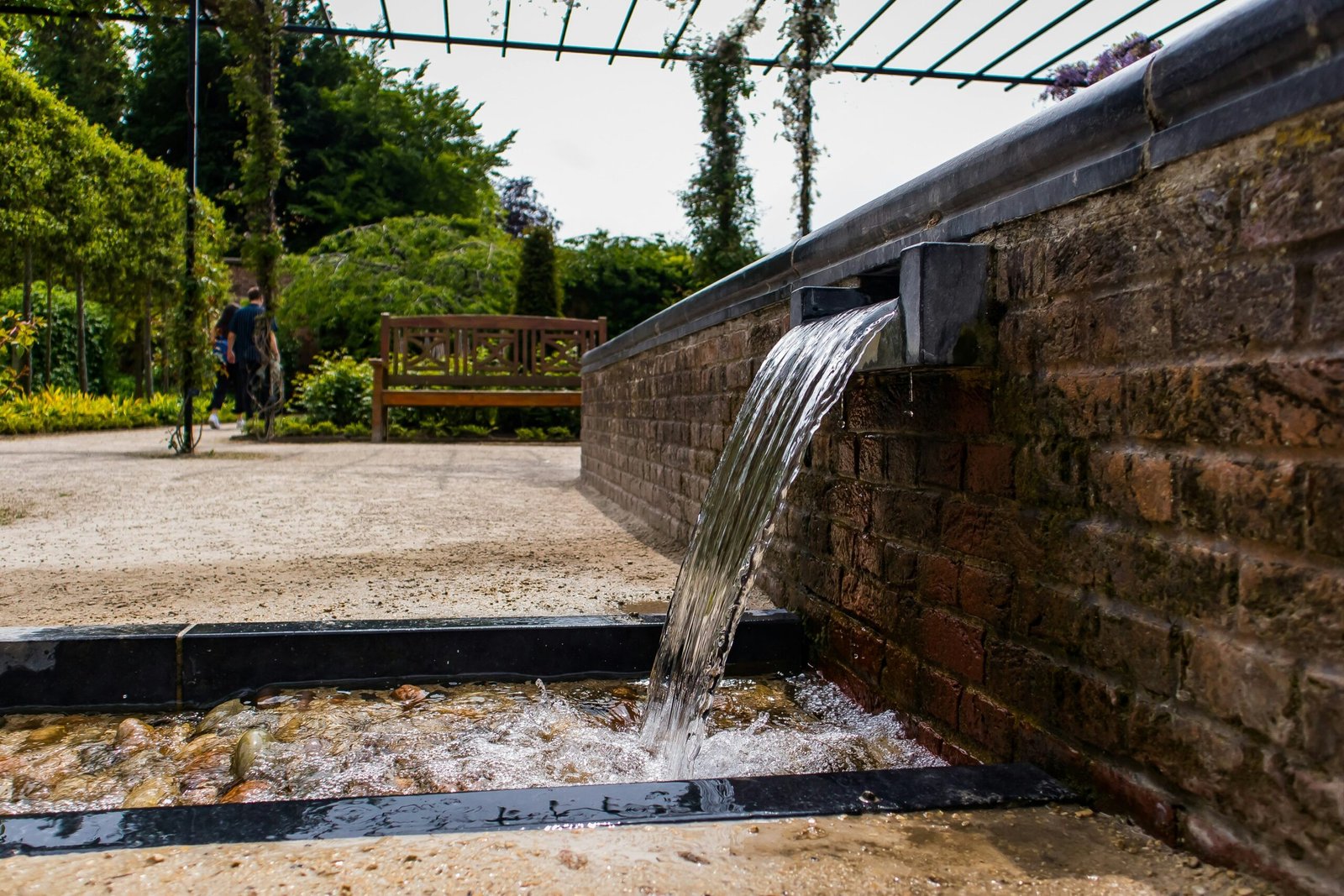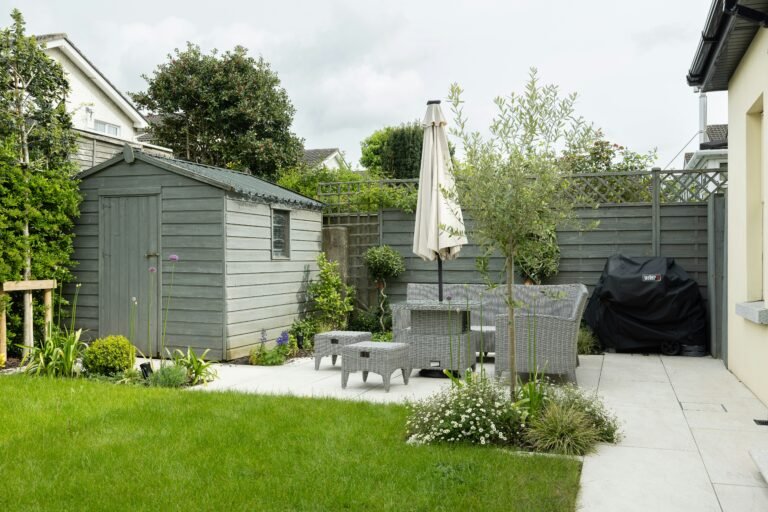There’s something timeless about the sound of moving water. Whether it’s the trickle of a small garden fountain or the gentle ripple across a backyard pond, water brings a sense of calm and vitality to any outdoor space. When I added my first garden water feature, I was surprised at how instantly it changed the atmosphere — suddenly, it wasn’t just a yard; it was a retreat.
Natural calm: sound, movement, and microclimate
Running water masks background noise and introduces a soothing rhythm to your surroundings. According to a 2021 study in the Journal of Environmental Psychology, natural water sounds can lower heart rate and reduce stress levels more effectively than silence or synthetic white noise. The constant movement also helps cool nearby spaces slightly by increasing humidity and air circulation. A small fountain or rill beside a patio or seating nook can create a microclimate that feels fresher and more inviting — perfect for reading, meditation, or evening relaxation.
Benefits for wildlife and biodiversity
Water features are not just aesthetic; they’re ecological. Birds, bees, butterflies, and amphibians are naturally drawn to clean, shallow water. The Royal Horticultural Society (RHS) notes that even the smallest wildlife pond can significantly increase biodiversity, providing drinking water, breeding sites, and shelter for pollinators and small creatures (RHS – Create a Wildlife Pond). Similarly, the National Wildlife Federation (NWF) highlights that adding water is one of the fastest ways to transform a standard garden into a certified wildlife habitat.
Want to supercharge the habitat around your pond’s edges? Try these plant picks in How to Create a Pollinator Friendly Garden for Bees & Butterflies.
Property value and curb appeal
Beyond serenity and ecology, a garden water feature can enhance property value. Real estate professionals from Better Homes & Gardens report that homes with thoughtfully designed water features often sell faster and at higher prices, as they project a sense of luxury and calm (Better Homes & Gardens – Add a Water Feature to Your Yard). A balanced mix of stone, foliage, and reflective water introduces texture and motion that static landscaping simply can’t match. Whether you’re looking to impress future buyers or simply elevate your outdoor experience, this is one garden investment that pays off both emotionally and visually.
Planning Your Garden Water Feature (Start Here)
Before you start digging or shopping for pumps, it’s essential to plan your garden water feature carefully. Good design always begins with intention, knowing why you want a feature and where it will serve your garden best. Planning well prevents costly mistakes and ensures your water feature blends naturally with its surroundings.
Clarify purpose: focal point, habitat, or white noise
Ask yourself what role the feature will play in your garden. Is it meant to be a focal point that draws the eye from the house or patio? A wildlife-friendly pond that supports frogs and dragonflies? Or perhaps a small garden fountain for the relaxing sound of water?
If your main goal is ambiance, a self-contained feature like an urn or wall fountain may be ideal. But if you’re after habitat or visual drama, a larger backyard pond could be more rewarding. The Royal Horticultural Society (RHS) recommends starting small — features under 2m² are easier to manage and still deliver major visual impact.
Site selection: sun, shade, views, and power access
Placement determines both the look and the longevity of your water feature. Choose a location that’s visible from key viewpoints — like your main seating area or kitchen window.
Avoid positioning directly under trees, as falling leaves can clog your pond pump and promote algae buildup. Most aquatic plants and solar-powered pumps perform best with at least 4–6 hours of sunlight per day, but a partially shaded spot helps control evaporation in hot climates.
Make sure there’s access to a safe outdoor electrical outlet or, alternatively, space for a solar pump. The U.S. Department of Energy notes that modern solar fountain kits can power small to mid-sized features efficiently in sunny regions (Energy.gov – Solar Water Pumps).
If you also want to capture and filter roof runoff nearby, pair your feature with How to Build a Rain Garden: Eco-Friendly Landscaping Tips.
Sizing for small, medium, and large gardens
Match your water feature to your garden’s proportions. A compact courtyard might benefit from a tabletop bowl fountain, while a suburban garden could handle a 2–3m pond or formal rill. Oversized features can dominate a space, while tiny ones may get visually lost.
As a general rule, aim for your feature to occupy no more than 10% of your visible garden area. Remember to account for edging, rocks, and planting margins, which can expand the overall footprint.
When I designed mine, I sketched the layout to scale on graph paper and placed markers in the garden before digging. It helped me visualize water movement and sightlines. Spending this extra hour saved me days of rework later.
Choosing the Right Garden Water Feature Style
The beauty of a garden water feature lies in how it complements your outdoor space’s mood and character. From sleek modern fountains to rustic backyard ponds, every style creates a distinct atmosphere. Choosing the right one depends on your available space, design taste, and maintenance expectations.

Small garden fountain vs. backyard pond vs. rill
Each style brings its own charm and purpose. A small garden fountain is compact, low-maintenance, and ideal for patios, decks, or balconies. You can find elegant stone urns, minimalist bowls, or cascading tiered fountains that provide instant ambiance without complex installation.
In contrast, a backyard pond creates a natural habitat — perfect if you’d like to attract frogs, dragonflies, or birds. It can be purely ornamental or include fish like koi or goldfish (though that requires filtration and extra care). Meanwhile, a rill — a narrow, shallow channel of moving water — adds a contemporary edge, especially in modern landscapes with clean lines.
According to Better Homes & Gardens, combining moving and still water elements, such as a small fountain feeding into a pond, can add depth and dimension to a medium-sized garden (Better Homes & Gardens – Add a Water Feature to Your Yard).
Above-ground bowls, urns, and container features
If space or budget is limited, above-ground designs are an excellent starting point. Ceramic bowls, metal basins, and repurposed containers can easily be converted into DIY water features with a small pond pump and tubing. These options require no digging and can be relocated if you change your layout.
For renters or balcony gardeners, solar-powered fountains that circulate water from an integrated basin are both sustainable and portable. The Gardener’s World magazine highlights that container water features are also great for growing aquatic plants like dwarf lilies or water hyacinths, bringing greenery to small urban spaces (Gardener’s World – Container Water Gardens).
Naturalistic wildlife pond vs. formal geometric look
When deciding between organic and structured aesthetics, consider your garden’s overall style. A naturalistic pond with curved edges, river rocks, and native plants blends into cottage or woodland gardens. It encourages biodiversity and mimics a small ecosystem.
A formal design, on the other hand, uses symmetry, straight edges, and defined borders — perfect for contemporary or classical settings. Think reflective pools lined with stone or concrete, paired with subtle LED lighting for a sleek nighttime effect.
I personally lean toward naturalistic features; watching insects and birds interact with the pond adds life and movement that no sculpture could replace. But for those who prefer a clean, architectural feel, geometric forms can provide calm through balance and simplicity.
Ultimately, your water feature should reflect how you want to feel in your garden — serene, inspired, or energized. Once you’ve chosen the style that resonates most, you’re ready to gather your materials and tools.
Essentials & Tools Checklist for a DIY Water Feature
Now that you’ve chosen your style, it’s time to gather the right components. A DIY water feature can be simple to build, provided you start with reliable materials and understand how each piece functions. Whether it’s a small garden fountain or a backyard pond, the setup revolves around a few key elements.
Core components: basin/liner, pond pump, tubing, prefilter
Every water feature relies on a few essentials:
- Basin or liner: This holds the water. For ponds, flexible PVC or EPDM liners are standard, while preformed fiberglass or plastic basins work well for fountains. The Royal Horticultural Society (RHS) recommends choosing UV-stabilized liners for longevity.
- Pond pump: The heart of the system. Select one based on the size and “head height” — the distance the water must be lifted. A pump that circulates the full volume of water once per hour is ideal. Brands like PondXpert and Oase are well-rated for efficiency and reliability.
- Tubing and prefilter: Tubes connect the pump to the outlet (such as a fountain spout or waterfall). A prefilter prevents debris from clogging the system and prolongs pump life.
A useful reference chart for matching pump size to feature volume can be found on Aquascape Inc.’s official site (Aquascape Pump Selection Guide).
Power options: outdoor-rated outlet vs. solar
If your garden has a safe, weatherproof outdoor outlet, plug-in pumps are powerful and consistent. However, solar-powered pumps are increasingly popular for small and medium features. They eliminate electrical wiring and reduce running costs. According to the U.S. Department of Energy, solar pump systems can perform efficiently in sunny regions while reducing energy consumption and environmental impact.
Solar models with built-in batteries can even operate for a few hours after sunset, a practical choice for those who enjoy evening garden ambiance.
Tools & materials: aggregate, edging, underlayment
Before installation day, prepare a toolkit that includes:
- Shovel or trowel (for digging basins)
- Level (to ensure even water distribution)
- Underlayment (protects pond liners from punctures by stones or roots)
- Gravel or aggregate (for base support and decoration)
- Edging materials like natural rock, brick, or timber
If you’re planning a larger backyard pond, adding a thin layer of sand beneath the liner helps cushion it and makes contouring easier. As The Spruce gardening guide notes, good groundwork ensures structural stability and prevents leaks later (The Spruce – How to Build a Pond).
When I built my own feature, I laid everything out on a tarp first — tubing, pump, liner, tools — and checked each piece off a list. It saved multiple trips back to the shed and made the build go far more smoothly. Preparation truly is half the project.
Step-by-Step: Installing a Garden Water Feature
You’ve got your tools and materials — now comes the rewarding part: building your garden water feature. Whether it’s a small garden fountain or a modest backyard pond, proper installation ensures smooth operation and lasting beauty. Below is a straightforward guide you can follow confidently.
Marking, digging, and lining
Start by marking your layout using a rope, spray paint, or a garden hose. This helps visualize the shape and size before any digging begins. Keep in mind the 10% garden coverage rule — your feature should complement, not dominate, the space.
Next, dig the basin according to your design. For ponds, dig in layers (shelves) about 20–30 cm deep to create planting zones for marginal plants and to help wildlife access the water safely. Remove stones or roots to prevent liner punctures.
Place underlayment first for protection, then spread the pond liner evenly, leaving generous overlap around the edges. Secure it temporarily with rocks or bricks. According to The Spruce’s pond installation guide, ensuring smooth, wrinkle-free liner placement prevents water loss and liner wear over time.
Pump placement, hose routing, and testing
Set the pond pump in the deepest section of your basin, ideally on a brick or flat stone to avoid sucking up debris. Connect tubing and route it toward the outlet — whether a fountain head, spillway, or mini waterfall. If using a DIY water feature made from containers or urns, hide tubing within the structure or behind rocks.
Fill your feature with water (rainwater is best if available) and test the pump. Adjust the water flow and check for leaks or uneven edges. The Aquascape pump setup guide suggests running the system for at least 30 minutes to confirm consistent performance.
Tip: When testing, place a mesh filter or nylon stocking over the pump intake. It’s an inexpensive way to prevent clogging during initial setup.
Rocking, edging, and disguising hardware
Once your pump runs smoothly, it’s time to add the finishing touches. Use river rocks, pebbles, or flat stones to anchor the liner edges and conceal cables or tubing. Avoid using mortar unless you’re creating a permanent fixture — flexibility makes future maintenance easier.
To disguise the pump housing, stack rocks naturally or plant low-growing perennials like creeping Jenny, ferns, or sedges nearby. For container fountains, decorative gravel or glass pebbles can hide the water outlet beautifully.
As Better Homes & Gardens recommends, blending natural textures and colors helps your water feature look “as though it’s always belonged there” (Better Homes & Gardens – Add a Water Feature to Your Yard).
When I completed my first installation, I was amazed at how the garden’s mood changed instantly – from silent to serenely alive. Water brings an unmistakable rhythm that transforms even the simplest backyard.
Water Quality, Safety, and Maintenance
Once your garden water feature is running, keeping it clean and safe ensures it remains a true sanctuary rather than a source of frustration. Regular maintenance protects the pump, prevents algae blooms, and keeps your water clear and inviting for people and wildlife alike.

Algae control, filtration, and circulation basics
Algae growth is a natural part of any pond ecosystem, but too much can turn your water cloudy or green. To control it, focus on filtration and balance. A pond pump with a built-in filter helps keep water circulating, which limits stagnant zones where algae thrive. Add aquatic plants like water lilies or hornwort to provide shade and absorb excess nutrients. The Royal Horticultural Society (RHS) recommends covering about two-thirds of your pond’s surface with plants to naturally reduce algae (RHS – Controlling Algae in Ponds).
Avoid overfeeding fish or adding chemical treatments unless absolutely necessary — these can upset the pond’s biological balance. For small garden fountains, a few drops of natural barley extract or a weekly rinse keeps the basin clear without harming wildlife.
If you’re using a DIY water feature with a simple recirculating pump, clean the prefilter once every two weeks and check tubing for buildup. As Aquascape Inc. notes, “consistent light maintenance is far easier than seasonal overhauls”.
Child, pet, and electrical safety
Safety is crucial, especially for families. Even shallow ponds can be risky for small children or pets. Consider using a pond safety grille or mesh just below the surface, which allows water and plants to move freely but prevents accidents. For electrical connections, use outdoor-rated, GFCI-protected outlets and ensure all cables are buried or covered. The U.S. Consumer Product Safety Commission (CPSC) advises inspecting cords and connectors annually for wear or moisture exposure (CPSC – Outdoor Electrical Safety). If you’re using a solar pump, position panels securely and avoid running cables across pathways where they could trip someone.
Seasonal care: winterizing and spring startup
Each season brings its own maintenance needs:
- Spring: Clean out debris, trim back overgrown plants, and restart your pump. Check for leaks or cracks caused by freezing.
- Summer: Top up water levels regularly, especially during heatwaves. Use rainwater where possible to reduce chemical buildup.
- Autumn: Skim fallen leaves frequently or install a fine mesh net over ponds.
- Winter: In cold regions, remove pumps from freezing water, drain above-ground containers, and store them indoors. If your pond houses fish, use a pond heater or floating ball to maintain an air hole for gas exchange.
When I first started maintaining my own feature, I realized that a few minutes each week made all the difference – it stayed clean, the pump lasted longer, and the sound of water remained beautifully consistent year-round.
Budget, Timeframe, and What to DIY vs. Hire
Building a garden water feature can range from a weekend hobby project to a full-scale landscape investment. Understanding the typical costs and time requirements plus knowing when to hire help keeps your project realistic and stress-free.
Cost ranges by feature type and size
The overall cost depends largely on the design complexity, materials, and pump system. Based on HomeAdvisor estimates:
| Type | Average Cost (USD) | Typical Size | Maintenance |
|---|---|---|---|
| Small container fountain | $100–$300 | 1–3 ft² | Minimal (weekly cleaning) |
| Preformed pond (plastic or fiberglass) | $300–$800 | 3–6 ft² | Moderate |
| Custom backyard pond (liner-based) | $1,000–$3,000 | 6–15 ft² | Moderate–high |
| Waterfall or rill feature | $2,000–$5,000+ | Variable | Moderate–high |
Solar-powered features generally cost less to operate long-term, offsetting the initial investment slightly. If you’re creating a DIY water feature, budget an extra 10–15% for fittings, gravel, or replacement tubing – small items that add up quickly.
When to call a pro (electrical, large excavations)
DIY installation is satisfying, but not every step should be done alone. If your project requires:
- Electrical wiring, especially underground or near water
- Deep excavation (more than 45–60 cm)
- Large rock or waterfall installations requiring heavy lifting
… then hiring a professional is worth it. Licensed electricians ensure proper grounding and safety, while landscapers can handle grading and drainage — two aspects that directly affect your feature’s longevity. The National Association of Landscape Professionals (NALP) advises using certified installers for complex setups to avoid long-term maintenance and safety issues (NALP – Find a Landscape Professional).
Time estimates and staging the work
For a basic backyard pond or fountain, expect about one full weekend (10–15 hours) of active work. Larger installations may take 3–5 days, depending on excavation depth and curing time for edging materials.
Here’s a rough breakdown:
- Planning and design: 2–3 hours
- Site prep and digging: 4–6 hours
- Liner placement and pump setup: 2–3 hours
- Edging, rockwork, and finishing: 3–4 hours
To make the process manageable, I like to stage projects over two weekends, first for excavation and setup, then for aesthetics and planting. It keeps the pace enjoyable and allows for adjustments if the water flow or pump needs fine-tuning.
By balancing ambition with practicality, you’ll avoid burnout and end up with a garden water feature that feels effortless, both in looks and upkeep.
Design Ideas to Elevate Your Garden Water Feature
Once your garden water feature is installed and running smoothly, you can turn it from functional to unforgettable with the right design touches. Subtle additions from thoughtful planting to clever lighting will help you create an outdoor sanctuary that looks and feels truly serene.

Planting palettes: marginals, oxygenators, and pollinator picks
Plants soften hard edges and create a sense of natural integration. For backyard ponds, combine three types:
- Marginals like irises, sedges, and pickerelweed — thrive in shallow water at pond edges.
- Oxygenators such as hornwort and anacharis — maintain water clarity by absorbing excess nutrients.
- Floating plants like water lettuce or lilies — provide shade and habitat for wildlife.
The Royal Horticultural Society (RHS) suggests covering about two-thirds of the pond’s surface with vegetation to achieve ecological balance and reduce algae naturally.
For smaller features or container fountains, trailing plants like creeping Jenny or Bacopa drape beautifully over the sides. You can also use pollinator-friendly blooms like lavender, salvia, and verbena around your feature to attract bees and butterflies while adding bursts of color.
Lighting and sound tuning
A well-lit water feature glows after dark and enhances the soundscape at night. Use low-voltage LED lights designed for wet environments, such as submersible spotlights or floating orbs. Position lights beneath small cascades or behind rippling water to highlight movement and texture.
Warm white or amber hues are ideal for creating a tranquil evening ambiance. According to Better Homes & Gardens, subtle downlighting or hidden uplighting can make even a modest DIY water feature appear professionally designed (Better Homes & Gardens – Outdoor Lighting Ideas).
You can also “tune” your water sound. Adjusting pump flow or altering rock placement changes tone and volume. Higher drops create energetic splashes; gentle streams offer meditative calm. I like to listen to mine at different times of day, morning trickles feel soothing, while evening cascades seem almost musical.
For a full guide to fixtures, beam angles, and cozy color temps, see Outdoor Garden Lighting: Best Ideas to Highlight Your Landscape.
Add-ons: stepping stones, seating nooks, and paths
To complete the retreat feel, think about how people will experience your water feature. Add stepping stones that let you approach the water safely, or create a small gravel path bordered with ornamental grasses for movement and texture.
A simple wooden bench or stone seat placed nearby invites relaxation. The National Garden Scheme (UK) notes that proximity encourages mindfulness — hearing water while sitting still for just five minutes can lower stress and enhance mood.
Even in a compact space, these small details create immersion. When I added a single weathered bench beside my pond, it changed how I used my garden entirely — suddenly, it wasn’t just decoration; it was a daily escape.
With thoughtful design layers — plants, light, and access — your water feature becomes a living, ever-changing centerpiece that enriches all senses.
Common Mistakes (and Quick Fixes)
Even the best-planned garden water feature can run into a few hiccups. The good news? Most problems are easy to fix once you understand their root causes. Here’s how to avoid the most common pitfalls — and how to repair them if they occur.
Undersized pond pump or wrong head height
Choosing the wrong pond pump is one of the most frequent mistakes. A pump that’s too weak won’t circulate the water properly, leading to stagnation, mosquito growth, or algae buildup. Conversely, an overly powerful pump can cause excessive splashing and noise.
To avoid this, calculate your required head height (the vertical distance the pump must lift water) and total volume. As Aquascape Inc. advises, your pump should circulate the entire pond volume at least once per hour for healthy water turnover.
If your flow feels sluggish, check for kinked tubing or debris blocking the intake. Replacing tubing or cleaning filters often restores pressure immediately.
Leaks from folds, edges, or splash-out
If your water level drops faster than normal evaporation (1–2 cm per day), you might have a leak. The RHS suggests checking edges first — sometimes the liner slips beneath rocks, allowing water to escape (RHS – Pond Leaks and Repairs).
To find leaks:
- Turn off the pump and let the water settle.
- Observe where the waterline stabilizes.
- Inspect that level carefully for small tears or liner folds.
A patch repair kit (PVC or EPDM) typically fixes the issue. For DIY water features with hidden reservoirs, splash-out is often the culprit — adding larger stones around the spout or adjusting pump flow reduces water loss significantly.
Overstocking fish and feeding issues
If your backyard pond includes fish, resist the temptation to overstock. Too many fish lead to poor water quality and excess waste, overwhelming your filtration system. The National Wildlife Federation (NWF) recommends one inch of fish per square foot of pond surface for balanced ecosystems (NWF – Garden for Wildlife).
Feed fish sparingly — only what they’ll eat in two to three minutes, once daily. Uneaten food decomposes and fuels algae growth. If your water starts turning murky or green, do a 20% partial water change and reduce feeding frequency.
Other quick fixes
- Pump noise: Vibrations may travel through surfaces; placing a rubber mat or flat stone under the pump often solves it.
- Foamy water: Usually caused by organic matter buildup — remove decaying leaves and change part of the water.
- Cloudy water after rain: Check runoff sources; redirect garden drainage away from your pond or fountain.
When I built my first water feature, I learned most lessons through trial and error — but those fixes taught me how forgiving water can be. Once balanced, it finds its rhythm again quickly.
Conclusion: Your Peaceful Retreat Awaits
Adding a garden water feature is more than just a landscaping upgrade, it’s a lifestyle enhancement. You’re not only shaping a beautiful outdoor space but also creating a daily sanctuary where sound, light, and movement blend into calm. When I built my first water feature, I realized it wasn’t about engineering or decoration. It was about rediscovering quiet moments close to home.
Whether it’s the shimmer of a small garden fountain, the gentle hum of a pond pump, or the reflections on a backyard pond, each version invites you to slow down and reconnect with nature. The rhythm of water has an unmatched ability to transform stress into stillness. And the best part? You don’t need acres of land or thousands of dollars, just thoughtful planning, creativity, and a willingness to get your hands a little muddy.
So start small, learn as you go, and watch your garden come alive. The sooner you begin, the sooner you’ll have your own personal retreat waiting right outside your door. Proof that peace can be built, one ripple at a time.
Alex is the creator of Homely Haven, a space dedicated to simple, stylish ideas for interiors and gardens alike. With a passion for cozy living rooms, inviting outdoor spaces, and practical DIY solutions, Alex shares tips and guides that help turn any house into a true home.
From budget-friendly decorating hacks to weekend garden projects, the goal is always the same: to inspire you to create spaces that feel personal, beautiful, and welcoming. When not writing, Alex is usually rearranging furniture, sketching new garden layouts, or exploring design trends for the next project.








